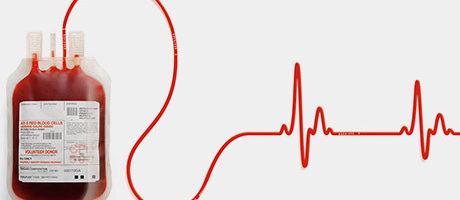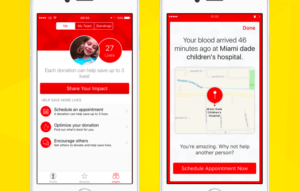Blood Donations in a Digital Age

How should the American Red Cross update its biomedical services in an increasingly digital age?
The American Red Cross receives 4.8 million blood donations per year, or over 13,000 blood donations per day. (1) Donated blood is a perishable good, lasting up to 42 days when refrigerated. (2) Thus, the American Red Cross manages a very large supply chain of perishable goods.
This supply chain rewards suppliers (aka, donors) with satisfaction and snacks instead of money in order to build up an inventory of blood and related products like platelets and plasma for eventual distribution to customers (aka, hospitals and patients). This essay will focus on the American Red Cross’s $1.7 billion of biomedical services related to blood donations and distribution, which are much larger in value than the non-profit organization’s other relief and training services. (3)
Digitalization Concerns
American Red Cross management is already concerned about the impact of digitalization on its supply chain. As donors and hospitals become more sophisticated with technology, they are likely to demand new convenience and visibility from the organization’s biomedical services. Wasted donations and shortages by blood type may no longer be tolerated, when less life-critical services like transportation (Lyft, Uber) and lodging (Airbnb) have already been successfully digitized. (4)
Donors want to optimize aspects of the donation experience such as scheduling, processing time, and visible impact and to minimize wasted donations. Hospitals want to maximize on-time distribution and quality for the medical needs of their patients. These parties may be able to deal more directly with each other in the future as technology continues to improve.
The Red Cross provides only about 40% of the nation’s blood supply. (5) About 50% of the nation’s blood supply is provided by a coalition of community blood centers called America’s Blood Centers, with the balance provided by hospitals directly and other community blood centers. (6) If the Red Cross does not address digitalization concerns, these competitors may be able to gain market share.
Current Steps
Red Cross management responded to digitalization concerns in late 2014 by releasing the free Blood Donor App for an “easier, faster, and more convenient” donation experience. (7) Donors can still access service by phone and online, but the app provides a competitively unique service channel. (8)
In the short term, several app features make the donation experience more convenient, likely increasing the Red Cross’s access to donors and blood supply. The app offers appointment search, scheduling, and reminders. Higher-value features include lifetime tracking of blood donations with an impact on up to three lives for each donation and gamification badges to share impact on social media. (9) These features align with the increasingly digital preferences of donors.
Another app feature is geo-targeted blood shortage alerts, which alert donors if their blood type is in need within their local community. (10) This feature effectively manages the supply chain by providing supply and demand visibility throughout the network. Donors are likely more willing to sacrifice an hour of their time when they are more certain that their donation will not be wasted.
In the medium term, Red Cross management wants to use technology “to connect more people to our lifesaving information and services.” (11) Though the organization has publicized its digital efforts to benefit donors, it has also improved testing and communication technology to respond more quickly to hospitals. The Red Cross can now transfer test results to hospitals in 24 hours. (12)
Recommended Steps
The app’s Blood Journey feature is intended to inform donors when and where their donation is used, as modeled in the picture below. Donor reviews indicate that this feature is often inoperative. (13) In the short term, more accurate displays of donation tracking, which is already conducted for medical safety reasons, would provide network customization. Both donors and hospitals would likely feel more connected to and incentivized to re-engage as a result of this customized data.
In the medium term, a supply chain forecast would also enhance network visibility. The Red Cross predictably faces blood shortages during summers due to more outdoor activity and injury, limited access to schools to host blood drives, and less donor availability. (14) A local supply chain forecast would help donors plan blood donations on a broader timeline than the current blood shortage alerts. Real-time tracking of actual hospital need would contextualize and improve this forecast.
The Red Cross should also communicate more closely with hospitals in order to reduce lead times between hospital need and distribution. This communication is likely to lead to updated technology, storage methods, and distribution methods within the supply chain.
Open Questions
After writing this essay, I wonder:
- How else can the Red Cross improve its digitalization with hospitals?
- Should the Red Cross include other blood drives on its Blood Donor App? This broader scope may allow the Red Cross to impact even the supply chain of its competitors.
(Word Count: 799)
(1) American Red Cross, 2016 Annual Report, p. 11, http://www.redcross.org/images/MEDIA_CustomProductCatalog/m64340273_Annual-Report-2016.pdf, accessed November 2017.
(2) American Red Cross, “What Happens to Donated Blood?,” http://www.redcrossblood.org/learn-about-blood/what-happens-donated-blood, accessed November 2017.
(3) American Red Cross, 2016 Consolidated Financial Statements, p. 4, https://p.widencdn.net/ghq1cy/2016_TheAmericanRedCross_CFS, accessed November 2017.
(4) Cristela Guerra, “Blood Shortage Has Red Cross Calling for More Donations,” Boston Globe, August 2, 2017, https://www.bostonglobe.com/metro/2017/08/02/blood-shortage-has-red-cross-calling-for-more-donations/rpLzkLYAOtYRh5vX17i6PM/story.html, accessed November 2017.
(5) 2016 Annual Report, p. 10.
(6) America’s Blood Centers, “What We Do,” http://www.americasblood.org/about-us/what-we-do.aspx, accessed November 2017.
(7) “Red Cross Sets World Record with Blood Donor App Downloads,” press release, September 10, 2014, on American Red Cross website, http://www.redcross.org/news/article/Red-Cross-Sets-World-Record-with-Blood-Donor-App-Downloads, accessed November 2017.
(8) Ibid.
(9) iTunes, “Blood Donor by American Red Cross,” https://itunes.apple.com/us/app/blood-donor-by-american-red-cross/id911428916?mt=8, accessed November 2017.
(10) Ibid.
(11) 2016 Annual Report, p. 1.
(12) American Red Cross, “What Happens to Donated Blood?”
(13) iTunes, customer review “So easy to schedule appointments!” by RPCVBG.
(14) Carter BloodCare, “Why Summer Is a Time of Need”, http://www.carterbloodcare.org/why-summer-is-a-time-of-need, accessed November 2017.




Hi Pratik,
Thank you for bringing this topic to light – I appreciate your lens on this supply chain, and would never have guessed it made up a majority of the Red Cross’s value.
Certainly, the US seems far ahead of the UK, and I am glad to discover it so – the digitisation already seems well under way and hopefully some of the more glitch-y aspects can be rectified fast, though of course there is a question of how to attract the best digital talent when companies like Uber, whom you mentioned, are causing a skyrocket of tech / engineer salaries, starving other poorer industries of the skills required?
One more change which I might suggest would be related to the forecasted demand which you mention. I believe that as well as helping donors plan their donations better, hospitals should go as far as disincentivising people to donate at some points of the year, if the busiest periods will be within their next minimum donation window.
Great article, Pratik. I’m glad to see the Red Cross embracing technology to get donors into their doors since their major barrier to donation (aside from needles) is the inconvenience of searching for a blood bank and waiting to donate. I would be interested to see if/when the app expands through the International Federation of Red Cross and Red Crescent Societies affiliates to include overseas blood donation centers. One potential concern for me is the “gamification” and tracking of blood donations on a mobile platform that could potentially expose personal health information of the donor or recipient if not well protected or anonymized.
Thank you Pratik for this interesting subject!
I wonder why “management is concerned about the impact of digitalization on its supply chain”, as it seems like an amazing asset for them. Finally they can have the donations when needed, facilitated by matching algorithms rather than having donors come at the wrong time or with the wrong type eventually being wasted.
To answer your questions on improving its communication with the hospitals using digitalization I would try to take a step further into digitalizing the blood storage rooms within the hospitals in a way that no one needs to manually update Red Cross or their application from the hospital side but rather once a blood of specific type is being taken from the shelf (using sensors) it will signal Red cross automatically and in real time. thereby reducing human mistakes and lead times and strengthening its competitive advantage.
Great article, Pratik! It’s so great to see technology being used for mission-based initiatives that really help people in need. I noted down a few things as I read your article that I’d love to share:
1) I didn’t realize that 50% of the blood donations come from these community blood centers! Although Red Cross might be worried about losing market share, I guess as a consumer I don’t really care where the blood is coming from; as a consumer, it would be great to see these organizations compete to eventually increase the size of the overall pie of blood donations rather than take away each other’s share. Hopefully that’s not what they’re being incentivized to do!
2) I donated twice to the Red Cross and while the process itself was pretty easy, I have been incredibly annoyed by their solicitations ever since; they used to call me three times per week asking for donations. I felt bad because I was busy and couldn’t donate, but I felt even worse saying no! From a customer/donor experience, they are ironically driving me away from donating. I like the digital app approach, at least for me, because it is familiar to what I would use to do this.
3) Facebook’s Social Good team recently released a feature that enables people and blood banks to request blood donations in disaster areas. I hope the Red Cross is partnering with them on this because they get WAY more distribution working with Facebook than they would asking people to download a specific Red Cross app.
Thanks again!
Thank you, Pratik, I enjoyed reading your essay. One question that it brought to my mind was just how much blood is the Red Cross wasting? Yes, there can be a mis-matching of blood needs and current donations and whole blood can only be stored for 42 days. However, plasma (which makes up 55% of the blood) can be taken out of the blood and kept for a year. My understanding is that only 45% of whole blood expires after 42 days. It would be interesting to have numbers on how much blood can’t be matched to a patient need within the 42 days to get a better picture of just how much the Red Cross needs to “up their game” in their supply chain.
I don’t disagree that the Red Cross needs to make digital improvements to provide more visibility and transparency, and I enjoyed learning about the ways that they are responding to these challenges.